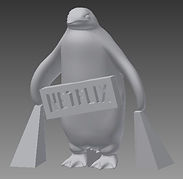

Happyfeet
Arcade
Game
Happyfeet: The Game was created from the nostalgic experience of playing early video game systems like Nintendo, Super NES, Sega, and various arcade games.
As I thought about the arrival of my niece for the holidays, I thought about a way to bond and spend time with her using an activity that we can both enjoy. The resulting idea was a game that resembled early two-dimensional arcade games, and used recent children’s stories and characters for content. It’s a game with a storyline that children will know, and a level of simplicity that people of all ages can relate to.



Concept
The chosen theme for the game concept was to create an interactive and stimulating experience using light, motion, and sound. The story’s main character would be positioned somewhere in reference to the game controls and screen, and have a physical reaction triggered by a particular outcome in the game.
Early video game systems such as the Nintendo Game Boy, Playstation controller, and arcade housing inspired user interaction and user experience design.
The chosen theme for the game concept was to create an interactive and stimulating experience using light, motion, and sound. The story’s main character would be positioned somewhere in reference to the game controls and screen, and have a physical reaction triggered by a particular outcome in the game.
Early video game systems such as the Nintendo Game Boy, Playstation controller, and arcade housing inspired user interaction and user experience design.


Drawings of concept models and product architecture



3D Renderings
All renderings were created using Autodesk Inventor.

The 3D model for the upper case was split into two separate sections to compensate for the limitations of additive manufacturing.




Electronics
The arcade game used the following electronic components:
-
Arduino Uno
-
Servo Motor
-
Potentiometer
-
Push buttons
-
LCD Screen
-
Piezo speaker

